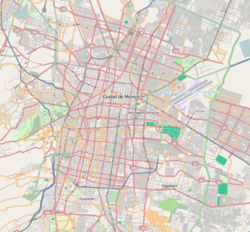| STC rapid transit | |||||||||||
 View of the platforms | |||||||||||
| General information | |||||||||||
| Other names | Toreo | ||||||||||
| Location | Naucalpan, State of Mexico Mexico | ||||||||||
| Coordinates | 19°27′35″N99°12′57″W / 19.459592°N 99.215899°W | ||||||||||
| Operated by | Sistema de Transporte Colectivo (STC) | ||||||||||
| Line(s) | | ||||||||||
| Platforms | 2 island platforms | ||||||||||
| Tracks | 3 | ||||||||||
| Connections |
| ||||||||||
| Construction | |||||||||||
| Structure type | Underground | ||||||||||
| Accessible | Yes | ||||||||||
| Other information | |||||||||||
| Status | In service | ||||||||||
| History | |||||||||||
| Opened | 22 August 1984 | ||||||||||
| Passengers | |||||||||||
| 2023 | 20,714,261 [1] | ||||||||||
| Rank | 3/195 [1] | ||||||||||
| Services | |||||||||||
| |||||||||||
| |||||||||||
Cuatro Caminos (translated from Spanish the name literally means "Four Roads") is a station of the Mexico City metro network. [2] [3] Colloquially known as "Metro Toreo", [4] [5] it is the north terminus of Line 2. The adjacent Mexipuerto Cementos Fortaleza Cuatro Caminos mixed-use development opened in 2016 [6] and houses, besides a shopping center, residential tower and sports facility, a bus terminal that is a hub for regional bus and minibus transport from and into the State of Mexico. [7] [8] [2] [9] In 2019, the station had an average ridership of 114,947 passengers per day, making it the third busiest station in the network. [10]
Contents
As of 14 September 1970 Line 2 originally terminated at Metro Tacuba, but on 22 August 1984 the line was extended an additional two stations to reach the municipality of Naucalpan. [9] The station sits on the dividing line between the Mexico City and the neighboring State of Mexico and as such was the first station of the network to be built outside the limits of the Federal District.


